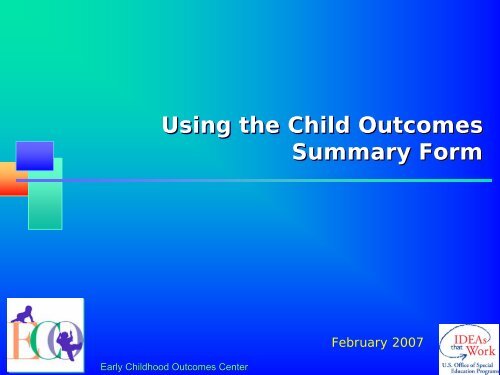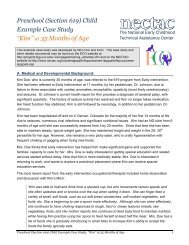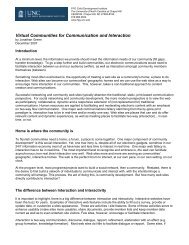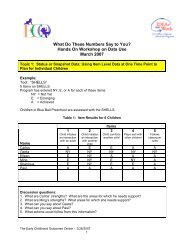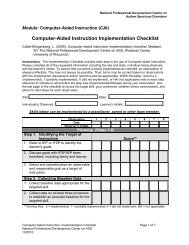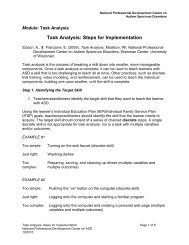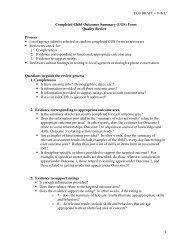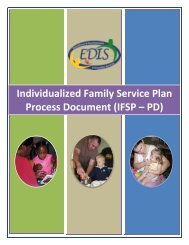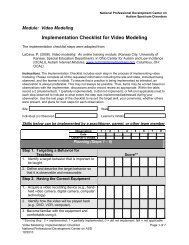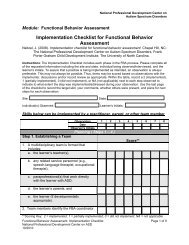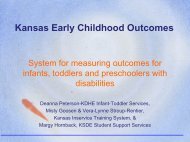Why Collect Outcome Data? - FPG Child Development Institute
Why Collect Outcome Data? - FPG Child Development Institute
Why Collect Outcome Data? - FPG Child Development Institute
You also want an ePaper? Increase the reach of your titles
YUMPU automatically turns print PDFs into web optimized ePapers that Google loves.
Using the <strong>Child</strong> <strong>Outcome</strong>sSummary FormEarly <strong>Child</strong>hood <strong>Outcome</strong>s CenterFebruary 2007
Goal of Early Intervention“…To enable young children to be active and successfulparticipants during the early childhood years and inthe future in a variety of settings – in their homes withtheir families, in child care, in preschool or schoolprograms, and in the community.”(from Early <strong>Child</strong>hood <strong>Outcome</strong>s Center,http://www.fpg.unc.edu/~eco/pdfs/eco_outcomes_4-13-05.pdf)Early <strong>Child</strong>hood <strong>Outcome</strong>s Center 3
<strong>Why</strong> <strong>Collect</strong> <strong>Outcome</strong> <strong>Data</strong>?Early <strong>Child</strong>hood <strong>Outcome</strong>s Center 4
Public Policy Context• Age of accountability• Accountability increasingly meanslooking at results, not just process• Office of Special EducationPrograms (OSEP) is underincreasing pressure to produceoutcome data on childrenparticipating in early interventionand early childhood specialeducation programsEarly <strong>Child</strong>hood <strong>Outcome</strong>s Center 5
PART Review Findings forPart C and Part B PreschoolResults not demonstratedPart C“While the program has met its goal relating to thenumber of children served, it has not collectedinformation on how well the program is doing toimprove the educational and developmental outcomesof infants and toddlers served.”Part B Preschool“The Department has no performance information onpreschool children with disabilities served by thisprogram.”Read more at ExpectMore.govEarly <strong>Child</strong>hood <strong>Outcome</strong>s Center 6
OSEP’s Response• Required states tosubmit outcome data intheir AnnualPerformance Report(APR)• Funded the Early<strong>Child</strong>hood <strong>Outcome</strong>sCenter to do research,make recommendations,and assist statesEarly <strong>Child</strong>hood <strong>Outcome</strong>s Center 7
The ECO Center’s Early Work• Convened stakeholders to identify child andfamily outcome areas and develop outcomestatements• Received input from state Part C and619 Coordinators, researchers, families,administrators, and the general publicEarly <strong>Child</strong>hood <strong>Outcome</strong>s Center 8
Result of Process: ECO Center MadeRecommendations to OSEPRecommendations on:• <strong>Child</strong> and family outcome statements(February 2005, revised April 2005)• Categories of information that should becollected about these outcomes (May 2005)Read more at www.the-eco-center.orgEarly <strong>Child</strong>hood <strong>Outcome</strong>s Center 9
OSEP Reporting Requirements:<strong>Child</strong> <strong>Outcome</strong>s• Positive social-emotional skills (including socialrelationships)• Acquisition and use of knowledge and skills(including early language/communication[and early literacy])• Use of appropriate behaviors to meet theirneedsEarly <strong>Child</strong>hood <strong>Outcome</strong>s Center 10
OSEP Reporting CategoriesPercentage of children who:a. Did not improve functioningb. Improved functioning, but not sufficient tomove nearer to functioning comparable tosame-aged peersc. Improved functioning to a level nearer tosame-aged peers but did not reach itd. Improved functioning to reach a levelcomparable to same-aged peerse. Maintained functioning at a level comparableto same-aged peers3 outcomes x 5 “measures” = 15 numbersEarly <strong>Child</strong>hood <strong>Outcome</strong>s Center 11
Reporting Schedule• Entry information (Age expected?Yes, No)• Must be reported for childrenentering between July 1, 2005, andJune 30, 2006• Due February 2007• <strong>Data</strong> in reporting categories at exitfor all children who have been inthe program for at least 6 months• Must be reported for the yearbeginning July 1, 2006• Due February 2008• Repeat with next year’s data in2009, etc.Early <strong>Child</strong>hood <strong>Outcome</strong>s Center 12
<strong>Why</strong> <strong>Collect</strong> <strong>Outcome</strong> <strong>Data</strong>?• Federal government is the driving force behindthe move to collect outcome data• However, providing data for the federalgovernment is not the only reason to collectoutcome dataEarly <strong>Child</strong>hood <strong>Outcome</strong>s Center 13
<strong>Why</strong> <strong>Collect</strong> <strong>Outcome</strong> <strong>Data</strong>?<strong>Data</strong> on outcomes are important for stateand local purposes.• To document program effectiveness• Increase in funding?• To improve programs• Identify strengths and weaknesses• Allocate support resources, such astechnical assistanceAnd, ultimately to better servechildren and familiesEarly <strong>Child</strong>hood <strong>Outcome</strong>s Center 14


